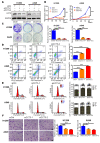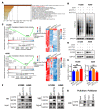Suppression of CCT3 Inhibits Tumor Progression by Impairing ATP Production and Cytoplasmic Translation in Lung Adenocarcinoma
- PMID: 35409343
- PMCID: PMC9000022
- DOI: 10.3390/ijms23073983
Suppression of CCT3 Inhibits Tumor Progression by Impairing ATP Production and Cytoplasmic Translation in Lung Adenocarcinoma
Abstract
Heat shock proteins are highly expressed in various cancers and exert critical functions in tumor progression. However, their expression patterns and functions in lung adenocarcinoma (LUAD) remain largely unknown. We identified that chaperonin-containing T-complex protein-1 subunit 3 (CCT3) was highly expressed in LUAD cells and was positively correlated with LUAD malignancy in the clinical samples. Animal studies showed that silencing CCT3 dramatically inhibited tumor growth and metastasis of LUAD. Proliferation and migration were markedly suppressed in CCT3-deficient LUAD cells. Moreover, the knockdown of CCT3 promoted apoptosis and cell cycle arrest. Mechanistically, the function of glycolysis was significantly inhibited and the total intracellular ATP levels were reduced by at least 25% in CCT3-deficient cells. In addition, the knockdown of CCT3 decreased the protein translation and led to a significant reduction in eukaryotic translation initiation factor 3 (EIF3G) protein, which was identified as a protein that interacts with CCT3. Impaired protein synthesis and cell growth in EIF3G-deficient cells were consistent with those caused by CCT3 knockdown in LUAD cells. Taken together, our study demonstrated in multiple ways that CCT3 is a critical factor for supporting growth and metastasis of LUAD, and for the first time, its roles in maintaining intracellular ATP levels and cytoplasmic translation are reported. Our novel findings provide a potential therapeutic target for lung adenocarcinoma.
Keywords: ATP production; CCT3; cytoplasmic translation; growth; lung adenocarcinoma; metastasis.
Conflict of interest statement
The authors declare no conflict of interest. The funders had no role in the design of the study; in the collection, analyses, or interpretation of data; in the writing of the manuscript, or in the decision to publish the results.
Figures






Similar articles
-
Integrated analyzes identify CCT3 as a modulator to shape immunosuppressive tumor microenvironment in lung adenocarcinoma.BMC Cancer. 2023 Mar 14;23(1):241. doi: 10.1186/s12885-023-10677-w. BMC Cancer. 2023. PMID: 36918801 Free PMC article.
-
Upregulation of CCT3 predicts poor prognosis and promotes cell proliferation via inhibition of ferroptosis and activation of AKT signaling in lung adenocarcinoma.BMC Mol Cell Biol. 2022 Jun 30;23(1):25. doi: 10.1186/s12860-022-00424-7. BMC Mol Cell Biol. 2022. PMID: 35773623 Free PMC article.
-
Chaperonin containing TCP1 subunit 3 (CCT3) promotes cisplatin resistance of lung adenocarcinoma cells through targeting the Janus kinase 2/signal transducers and activators of transcription 3 (JAK2/STAT3) pathway.Bioengineered. 2021 Dec;12(1):7335-7347. doi: 10.1080/21655979.2021.1971030. Bioengineered. 2021. PMID: 34612768 Free PMC article.
-
Advances in the study of CCT3 in malignant tumors: A review.Medicine (Baltimore). 2025 Feb 7;104(6):e41069. doi: 10.1097/MD.0000000000041069. Medicine (Baltimore). 2025. PMID: 39928781 Free PMC article. Review.
-
Current understanding on the role of CCT3 in cancer research.Front Oncol. 2022 Sep 15;12:961733. doi: 10.3389/fonc.2022.961733. eCollection 2022. Front Oncol. 2022. PMID: 36185198 Free PMC article. Review.
Cited by
-
CCT3/ACTN4/TFRC axis protects hepatocellular carcinoma cells from ferroptosis by inhibiting iron endocytosis.J Exp Clin Cancer Res. 2024 Aug 29;43(1):245. doi: 10.1186/s13046-024-03169-7. J Exp Clin Cancer Res. 2024. PMID: 39210442 Free PMC article.
-
Revisiting the chaperonin T-complex protein-1 ring complex in human health and disease: A proteostasis modulator and beyond.Clin Transl Med. 2024 Feb;14(2):e1592. doi: 10.1002/ctm2.1592. Clin Transl Med. 2024. PMID: 38363102 Free PMC article. Review.
-
Silencing CCT3 induces ferroptosis through the NOD1-NF-κB signaling pathway in bladder cancer.Sci Rep. 2024 Oct 31;14(1):26188. doi: 10.1038/s41598-024-76724-z. Sci Rep. 2024. PMID: 39478031 Free PMC article.
-
Integrated analyzes identify CCT3 as a modulator to shape immunosuppressive tumor microenvironment in lung adenocarcinoma.BMC Cancer. 2023 Mar 14;23(1):241. doi: 10.1186/s12885-023-10677-w. BMC Cancer. 2023. PMID: 36918801 Free PMC article.
-
A potential tumor marker: Chaperonin containing TCP‑1 controls the development of malignant tumors (Review).Int J Oncol. 2023 Sep;63(3):106. doi: 10.3892/ijo.2023.5554. Epub 2023 Aug 4. Int J Oncol. 2023. PMID: 37539774 Free PMC article. Review.
References
MeSH terms
Substances
Grants and funding
LinkOut - more resources
Full Text Sources
Medical
Research Materials
Miscellaneous

